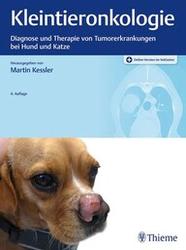
Bei der Katze sind Analbeuteltumoren extrem selten; in der Literatur existieren nur wenige Einzelfallberichte [40] [48] [80] und 2 größere Fallserien [2] [67]. In einer Fallserie [67] waren Kätzinnen (61 %) gegenüber Katern (39 %) häufiger vertreten, in der anderen [2] lag ein ausgeglichenes Geschlechterverhältnis vor. Siamkatzen waren in beiden Serien überrepräsentiert [2] [67]. Das Alter lag zwischen 6 und 17 Jahren (Ø 12 bzw. 13 Jahre) [2] [67].
Das häufigste klinische Symptom ist eine perianale Zubildung, die oftmals ulzeriert und vielfach initial für einen Analbeutelabszess gehalten wird (Abb. 1). In den beiden beschriebenen Fallserien wurden 28 % bzw. 85 % der Patienten mit einer perianalen Ulzeration vorgestellt [2] [67]. Daneben wurden Dyschezie, rezidivierende Verstopfung und Veränderungen im Volumen oder im Durchmesser des Kotes beobachtet. Die Tumoren sind fast immer unilateral und typischerweise 1–2 cm im Durchmesser (median 2 cm), wobei ein Tumordurchmesser von bis zu 6 cm beschrieben wurde [2] [67].
Histologisch zeigt sich der Tumor lokal infiltrativ, gelegentlich findet sich eine Lymphgefäßinfiltration. Eine Einteilung in 3 Tumorgrade unter Berücksichtigung von Differenzierungsgrad, nukleärem Pleomorphismus, mitotischem Index und einer Bewertung der scirrhösen Reaktion/Nekrose/Entzündung wurde beschrieben, in der Multivarianzanalyse erwies sich aber nur ein erhöhter nukleärer Pleomorphismus als prognostisch [2]. Eine Immunhistochemie mit CAM5.2-Antizytokeratin war in einer Studie im Primärtumor und in den sublumbalen Metastasen positiv [67].

Abb.1 - Analbeutelkarzinom im linken Analbeutel bei einer Katze. Die Tumoren sind häufig ulzeriert. Vermehrtes Belecken der Analregion durch die Katze führt vielfach zur Entdeckung der Veränderung, die oft initial als Analbeutelentzündung fehldiagnostiziert wird.
Auch bei der Katze kommt es häufig zu einer Metastasierung in die sublumbalen Lymphknoten, daneben aber auch in die Lunge und andere Organe [2] [67] [80]. Eine paraneoplastische Hyperkalzämie ist selten. In den publizierten Fallserien zeigten nur 1 von 5 bzw. 3 von 27 Katzen eine ggr. Hyperkalzämie [2] [67]. Ob die Hyperkalzämie in diesen Fällen wie beim Hund durch die Freisetzung eines parathormonähnlichen Peptids durch den Tumor hervorgerufen wird, blieb bislang nicht näher untersucht.
Sofern möglich wird eine weite chirurgische Resektion empfohlen, dabei kann aufgrund der lokalen Invasion eine Resektion von Teilen der Rektumwand indiziert sein. In einer Serie konnte nur in der Hälfte der Fälle eine histologisch komplette Exzision erreicht werden [2]. Die Prognose ist vorsichtig bis ungünstig. Das Erreichen einer kompletten Exzision (Schnittrandüberprüfung!) und der Grad des nukleären Pleomorphismus wurden in der Multivarianzanalyse als wichtigste prognostische Kriterien identifiziert [2]. Informationen über den Erfolg einer Chemotherapie und/oder Bestrahlungstherapie liegen kaum vor.
Take-Home-Message
- Analbeuteltumore bei Katzen sehr selten
- Siamkatzen am häufigsten betroffen
- Auftreten fast immer unilateral
- Häufig Metastasierung in sublumbale Lymphknoten
- Weite Chirurgische Resektion empfohlen
Dies ist ein Auszug aus:
Tumoren im Bereich des Afters. In: Kessler M, Hrsg. Kleintieronkologie. 4., vollständig überarbeitete Auflage. Stuttgart: Thieme; 2022
(JD)
[1] Aguirre-Hernández J, Polton G, Kennedy LJ et al. Association between anal sac gland carcinoma and dog leukocyte antigen-DQB1 in the English Cocker Spaniel. Tissue Antigens. 2010; 76: 476–481
[2] Amsellem PM, Cavanaugh RP, Chou PY et al. Apocrine gland anal sac adenocarcinoma in cats: 30 cases (1994–2015). J Am Vet Med Assoc. 2019; 254: 716–722
[3] Anderson CL, MacKay CS, Roberts GD et al. Comparison of abdominal ultrasound and magnetic resonance imaging for detection of abdominal lymphadenopathy in dogs with metastatic apocrine gland adenocarcinoma of the anal sac. Vet Comp Oncol. 2015; 13: 98–105
[4] Barnes DC, Demetriou JL. Surgical management of primary, metastatic and recurrent anal sac adenocarcinoma in the dog: 52 cases. J Small Anim Pract. 2017; 58: 263–268
[5] Bennett PF, DeNicola DB, Bonney P et al. Canine anal sac adenocarcinomas: clinical presentation and response to therapy. J Vet Intern Med. 2002; 16: 100–104
[6] Berrocal A, Vos JH, van den Ingh TS et al. Canine perineal tumours. Zbl Vet Med A. 1989; 36: 739–749
[7] Bowlt KL, Friend EJ, Delisser P et al. Temporally separated bilateral anal sac gland carcinomas in four dogs. J Small Anim Pract. 2013; 54: 432–436
[8] Brodzki A, Łopuszyński W, Brodzki P et al. Diagnostic and prognostic value of cellular proliferation assessment with Ki-67 protein in dogs suffering from benign and malignant perianal tumors. Folia Biol (Krakow). 2014; 62: 235–241
[9] Brown RJ, Newman SJ, Durtschi DC et al. Expression of PDGFR-β and Kit in canine anal sac apocrine gland adenocarcinoma using tissue immunohistochemistry. Vet Comp Oncol. 2012; 10: 74–79
[10] Byrne S, Wong H, Priestnall S et al. Prognostic factors in canine anal sac adenocarcinoma: clinical, histopathological features, Ki-67 and COX-2 expression in 82 dogs. Proc Ann Conf ESVONC, Las Palmas, 2018; 60
[11] Dow SW, Olsen PN, Rosychuck RAW et al. Perianal adenomas and hypertestosteronemia in a spayed bitch with pituitary-dependent hyperadrenocorticism. J Am Vet Med Assoc. 1988; 192: 1439–1441
[12] Elliott JW, Blackwood L. Treatment and outcome of four cats with apocrine gland carcinoma of the anal sac and review of the literature. J Feline Med Surg. 2011; 13: 712–717
[13] Emms SG. Anal sac tumours of the dog and their response to cytoreductive surgery and chemotherapy. Aust Vet J. 2005; 83: 340–343
[14] Esplin DG, Wilson SR, Hullinger GA. Squamous cell carcinoma of the anal sac in five dogs. Vet Pathol. 2003; 40: 332–334
[15] Farris HE, Fraunfelder FT, Firth CH. Cryosurgical treatment of canine perianal gland adenomas. Canine Pract. 1976; 3: 34–37
[16] Frese K, Durchfeld D, Eskens U. Klassifikation und biologisches Verhalten der Haut- und Mammatumoren von Hund und Katze. Prakt Tierarzt. 1989; 70: 69–82
[17] Ganguly A, Wolfe LG. Canine perianal gland carcinoma-associated antigens defined by monoclonal antibodies. Hybridoma (Larchmt). 2006; 25: 10–14
[18] Gillette EL. Radiation therapy of canine and feline tumors. J Am Anim Hosp Assoc. 1976; 12: 359–362
[19] Giuliano A, Dobson J, Mason S. Complete Resolution of a Recurrent Canine Anal Sac Squamous Cell Carcinoma with Palliative Radiotherapy and Carboplatin Chemotherapy. Vet Sci. 2017; 4 pii: E45
[20] Giuliano A, Salgüero R, Dobson J. Metastatic anal sac carcinoma with hypercalcaemia and associated hypertrophic osteopathy in a dog. Open Vet J. 2015; 5: 48–51
[21] Hause WR, Stevenson S, Meuten DJ et al. Pseudohyperparathyreoidism associated with adenocarcinomas of anal sac origin in four dogs. J Am Anim Hosp Assoc. 1981; 17: 373–379
[22] Hayes HM, Wilson GP. Hormone dependent neoplasms of the canine perianal gland. Cancer Res. 1977; 37: 2068–2071
[23] Heaton CM, Fernandes AFA, Jark PC et al. Evaluation of toceranib for treatment of apocrine gland anal sac adenocarcinoma in dogs. J Vet Intern Med. 2020; 34: 873–881
[24] Hobson HP, Brown MR, Rogers KS. Surgery of metastatic anal sac adenocarcinoma in five dogs. Vet Surg. 2006; 35: 267–270
[25] Kessler M. Der klinische Fall – Analbeutelkarzinom mit Hyperkalzämie bei einer Hündin. Tierärztl Prax. 1995; 23: 436, 521–524
[26] Kessler M, von Bomhard D. Rasseprädispositionen und Geschlechtsverteilung bei 106 Hunden mit Analbeutelkarzinom. (unveröffentlicht), 1997
[27] Kessler M, Kühnel S. Das canine Analbeutelkarzinom – eine retrospektive Untersuchung bei 32 Patienten. (unveröffentlicht), 2011
[28] Keyerleber MA, Gieger TL, Erb HN et al. Three-dimensional conformal versus non-graphic radiation treatment planning for apocrine gland adenocarcinoma of the anal sac in 18 dogs (2002–2007). Vet Comp Oncol. 2012; 10: 237–245
[29] Knudsen CS, Williams A, Brearley MJ et al. COX-2 expression in canine anal sac adenocarcinomas and in non-neoplastic canine anal sacs. Vet J. 2013; 197: 782–787
[30] Kornberg M, Affolter V. Hyperkalzämie durch ein Analbeutelkarzinom. Kleintierprax. 1990; 35: 465–471
[31] Linden DS, Cole R, Tillson DM et al. Sentinel lymph node mapping of the canine anal sac using lymphoscintigraphy: A pilot study. Vet Radiol Ultrasound. 2019; 60: 346–350
[32] Liska WD, Withrow SJ. Cryosurgical treatment of perianal gland adenomas in the dog. J Am Anim Hosp Assoc. 1978; 14: 457–463
[33] London C, Mathie T, Stingle N et al. Preliminary evidence for biologic activity of toceranib phosphate (Palladia(®)) in solid tumours. Vet Comp Oncol. 2012; 10: 194–205
[34] Majeski SA, Steffey MA, Fuller M et al. Indirect computed tomographic lymphography for iliosacral lymphatic mapping in a cohort of dogs with anal sac gland adenocarcinoma: technique description. Vet Radiol Ultrasound. 2017; 58: 295–303
[35] Mayer MN, Lawson JA, Silver TI. Sonographic characteristics of presumptively normal canine medial iliac and superficial inguinal lymph nodes. Vet Radiol Ultrasound. 2010; 51: 638–641
[36] McQuown B, Keyerleber MA, Rosen K et al. Treatment of advanced canine anal sac adenocarcinoma with hypofractionated radiation therapy: 77 cases (1999–2013). Vet Comp Oncol. 2017; 15: 840–851
[37] Meier V, Besserer J, Roos M et al. A complication probability study for a definitive-intent, moderately hypofractionated image-guided intensity-modulated radiotherapy protocol for anal sac adenocarcinoma in dogs. Vet Comp Oncol. 2019; 17: 21–31
[38] Meier V, Polton G, Cancedda S et al. Outcome in dogs with advanced (stage 3b) anal sac gland carcinoma treated with surgery or hypofractionated radiation therapy. Vet Comp Oncol. 2017; 15: 1073–1086
[39] Mellanby RJ, Craig R, Evans H et al. Plasma concentrations of parathyroid hormone-related protein in dogs with potential disorders of calcium metabolism. Vet Rec. 2006; 159: 833–838
[40] Mellanby RJ, Foale R, Friend E et al. Anal sac adenocarcinoma in a Siamese cat. J Feline Med Surg. 2002; 4: 205–207
[41] Mellett S, Verganti S, Murphy S et al. Squamous cell carcinoma of the anal sacs in three dogs. J Small Anim Pract. 2015; 56: 223–225
[42] Messinger JS, Windham WR, Ward CR. Ionized hypercalcemia in dogs: a retrospective study of 109 cases (1998–2003). J Vet Intern Med. 2009; 23: 514–519
[43] Meuten DJ, Segre GV, Capen CC. Hypercalcemia in dogs with adenocarcinoma derived from apocrine glands of the anal sac. Biochemical and histomorphometric investigations. Lab Invest. 1983; 48: 428–435
[44] Ogawa B, Taniai E, Hayashi H et al. Neuroendocrine carcinoma of the apocrine glands of the anal sac in a dog. J Vet Diagn Invest. 2011; 23: 852–856
[45] Ogilvie GK, Moore AS. Managing the veterinary cancer patient. Veterinary Learning Systems Co. Trenton, 1995, S. 359
[46] Olsen JA, Sumner JP. Clinical hypocalcemia following surgical resection of apocrine gland anal-sac adenocarcinomas in 3 dogs. Can Vet J. 2019; 60: 591–595
[47] Palladino S, Keyerleber MA, King RG et al. Utility of computed tomography versus abdominal ultrasound examination to identify iliosacral lymphadenomegaly in dogs with apocrine gland adenocarcinoma of the anal sac. J Vet Intern Med. 2016; 30: 1858–1863
[48] Parry NM. Anal sac gland carcinoma in a cat. Vet Pathol. 2006; 43: 1008–1009
[49] Petterino C, Martini M, Castagnaro M. Immunohistochemical detection of growth hormone (GH) in canine hepatoid gland tumors. J Vet Med Sci. 2004; 66: 569–572
[50] Pisani G, Millanta F, Lorenzi D et al. Androgen receptor expression in normal, hyperplastic and neoplastic hepatoid glands in the dog. Res Vet Sci. 2006; 81: 231–236
[51] Pollard RE, Fuller MC, Steffey MA. Ultrasound and computed tomography of the iliosacral lymphatic centre in dogs with anal sac gland carcinoma. Vet Comp Oncol. 2017; 15: 299–306
[52] Polton G. Examining the heritability of anal sac gland carcinoma in cocker spaniels. J Small Anim Pract. 2009; 50: 57
[53] Polton G. Anal sac gland carcinoma in cocker spaniels. Vet Rec. 2007; 160: 244
[54] Polton GA, Brearley MJ. Clinical stage, therapy, and prognosis in canine anal sac gland carcinoma. J Vet Intern Med. 2007; 21: 274–280
[55] Polton GA, Brearley MJ, Green LM et al. Expression of E-cadherin in canine anal sac gland carcinoma and its association with survival. Vet Comp Oncol. 2007; 5: 232–238
[56] Polton GA, Mowat V, Lee HC et al. Breed, gender and neutering status of British dogs with anal sac gland carcinoma. Vet Comp Oncol. 2006; 4: 125–131
[57] Potanas CP, Padgett S, Gamblin RM. Surgical excision of anal sac apocrine gland adenocarcinomas with and without adjunctive chemotherapy in dogs: 42 cases (2005–2011). J Am Vet Med Assoc. 2015; 246: 877–884
[58] Pradel J, Berlato D, Dobromylskyj M et al. Prognostic significance of histopathology in canine anal sac gland adenocarcinomas: Preliminary results in a retrospective study of 39 cases. Vet Comp Oncol. 2018; 16: 518–528
[59] Preziosi R, Della Salda L, Ricci A et al. Quantification of nucleolar organiser regions in canine perianal gland tumours. Res Vet Sci. 1995; 58: 277–281
[60] Rijnberk A, Elsinghorst AM, Koeman JP. Pseudohyperparathyreoidism associated with perirectal adenocarcinomas in elderly female dogs. Tijdschr Diergeneesk. 1978; 103: 1069–1075
[61] Rohrer-Bley C, Stankeova S, Sumova A et al. Perianaldrüsenkarzinom-Metastasen bei einem Hund: Palliative Tumortherapie. Schweiz Arch Tierheilkd. 2003; 145: 89–94
[62] Ross JT, Scavelli TD, Matthiesen DT et al. Adenocarcinoma of the apocrine glands of the anal sac in dogs: a review of 32 cases. J Am Anim Hosp Assoc. 1991, 27: 349–355
[63] Rosol TJ, Capen CC, Danks JA et al. Identification of parathyroid hormone-related protein in canine apocrine adenocarcinoma of the anal sac. Vet Pathol. 1990; 27: 89–95
[64] Saba C, Ellis A, Cornell K. Hypocalcemia following surgical treatment of metastatic anal sac adenocarcinoma in a dog. J Am Anim Hosp Assoc. 2011; 47: e173–177
[65] Sakai H, Murakami M, Mishima H et al. Cytologically atypical anal sac adenocarcinoma in a dog. Vet Clin Pathol. 2012; 41: 291–294
[66] Schlag AN, Johnson T, Vinayak A et al. Comparison of methods to determine primary tumour size in canine apocrine gland anal sac adenocarcinoma. J Small Anim Pract. 2020; 61: 185–189
[67] Shoieb AM, Hanshaw DM. Anal sac gland carcinoma in 64 cats in the United Kingdom (1995–2007). Vet Pathol. 2009; 46: 677–683
[68] Skorupski KA, Alarcón CN, de Lorimier LP et al. Outcome and clinical, pathological, and immunohistochemical factors associated with prognosis for dogs with early-stage anal sac adenocarcinoma treated with surgery alone: 34 cases (2002–2013). J Am Vet Med Assoc. 2018; 253: 84–91
[69] Suzuki K, Morita R, Hojo Y et al. Immunohistochemical characterization of neuroendocrine differentiation of canine anal sac glandular tumours. J Comp Pathol. 2013; 149: 199–207
[70] Takagi H, Azuma K, Osaki T et al. High temperature hyperthermia treatment for canines exhibiting superficial tumors: A report of three cases. Oncol Lett. 2014; 8: 2055–2058
[71] Urie BK, Russell DS, Kisseberth WC et al. Evaluation of expression and function of vascular endothelial growth factor receptor 2, platelet derived growth factor receptors-alpha and -beta, KIT, and RET in canine apocrine gland anal sac adenocarcinoma and thyroid carcinoma. BMC Vet Res. 2012; 8: 67
[72] Vail DM, Withrow SJ, Schwarz PD et al. Perianal adenocarcinoma in the canine male: a retrospective study of 41 cases. J Am Anim Hosp Assoc. 1990; 26: 329–334
[73] Vinayak A, Frank CB, Gardiner DW et al. Malignant anal sac melanoma in dogs: eleven cases (2000 to 2015). J Small Anim Pract. 2017; 58: 231–237
[74] Vos JH, van den Ingh TS, Ramaekers FC et al. The expression of keratins, vimentin, neurofilament proteins, smooth muscle actin, neuron-specific enolase, and synaptophysin in tumors of the specific glands in the canine anal region. Vet Pathol. 1993; 30: 352–361
[75] White RAS, Gorman NT. The clinical diagnosis and management of rectal and pararectal tumors in the dog. J Small Anim Pract. 1987; 28: 87–107
[76] Williams LE, Gliatto JM, Dodge RK et al. Carcinoma of the apocrine glands of the anal sac in dogs: 113 cases (1985–1995). J Am Vet Med Assoc. 2003; 223: 825–831
[77] Wilson GP, Hayes HM. Castration for treatment of perianal gland adenomas in the dog. J Am Vet Med Assoc. 1979; 174: 1301–1303
[78] Wouda RM, Borrego J, Keuler NS et al Evaluation of adjuvant carboplatin chemotherapy in the management of surgically excised anal sac apocrine gland adenocarcinoma in dogs. Vet Comp Oncol. 2016; 14: 67–80
[79] Wouda RM, Hocker SE, Higginbotham ML. Safety evaluation of combination carboplatin and toceranib phosphate (Palladia) in tumour-bearing dogs: A phase I dose finding study. Vet Comp Oncol. 2018; 16: E52–E60
[80] Wright ZM, Fryer JS, Calise DV et al. Carboplatin chemotherapy in a cat with a recurrent anal sac apocrine gland adenocarcinoma. J Am Anim Hosp Assoc. 2010; 46: 66–69
[81] Yoshimoto S, Kato D, Kamoto S et al. Detection of human epidermal growth factor receptor 2 overexpression in canine anal sac gland carcinoma. J Vet Med Sci. 2019; 81: 1034–1039




